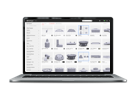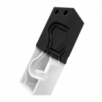
Farason Corporation Application Spotlight: Quick Change Mounting Plate
For over thirty years, Farason Corporation has designed and supplied custom automation and robotics systems to manufacturers, shipping over 900 machines to North America, Asia, South America, and Europe. The Farason team added Markforged 3D printers to enhance design and production capabilities. This aligns with Farason's commitment to delivering unique solutions tailored precisely to customers' specific challenges. The company utilized Markforged to develop a custom quick-change mounting plate for a vacuum gripper end-of-arm tooling solution.

Quick-change mounting plate printed in Onyx® and continuous carbon fiber
The challenge
Because the packaged goods to be moved (filled shampoo bottles) were heavy, irregularly shaped, and moved quickly through the line, conventional off-the-shelf packaging solutions designed for lift-and-transfer weighed too much for the robot's payload limits, preventing the targeted cycle rate and travel distances. With a high product mix, the removal and replacement of quick-change Onyx® mounting plates and custom continuous carbon fiber EOAT were required, but conventional (custom-machined Delrin parts) are a poor solution: a single-product solution for each changeover would negatively impact the production schedule and would be too cost-effective to accommodate changes in available robots and the packages being handled.
According to the Farason team, a custom EOAT was required, but conventional (milled from Delrin) parts are a poor solution:
- The parts are expensive and can be too heavy for high clock speeds.
- Performance-optimized EOAT requires multiple costly milling fixtures to deliver features along multiple axes, resulting in higher costs and longer lead times when manufactured off-site.
- Further weight reduction steps can improve lightweight construction, but may redesign a part, increasing the risk of scrap and causing additional delays.
- The production of customized EOAT individual parts does not scale well with changes in automation platforms and product packaging.
The solution
Richard Cook, R&D Support Engineer at Farason, leveraged the capabilities of industrial 3D printing in combination with other machine components to develop a custom quick-change mounting plate and locating plate system. These hybrid parts reduced the size, weight, and part count of a conventional end-of-arm vacuum gripper quick-change system while incorporating proven gripper components. Richard Cook highlighted that the resulting lightweight EOAT solution not only achieves a cycle rate of 80 parts per minute, including long travels of over 26 inches, but this production-ready solution also enables tool-free changeovers when changing between the product-facing locating plates.
Christian Weder, Design Support Engineer, plays a key role at Farason in supporting the design and manufacture of 3D-printed parts using Markforged equipment. He said, "Choosing 3D printing as the basis for this tool was really good, allowing us to incorporate machine parts while reducing the amount of aluminum. Keeping this tool lightweight is very important because we move so quickly." Christian Weder further noted that an alternative part made of machined Delrin would likely not achieve the same target weight for the robot's payload, and the effort required to remove further material and add features carries the risk of scrapping a machined part, drastically increasing the time to delivery to the customer.
"I know that if the customer needs a different part in a year, we'll be able to manufacture it. The printed part will fit; it won't have a different thickness or surface finish, or any other elements that might pose a challenge for the customer."
– Richard Cook, R&D Support Engineer, Farason Corporation

Quick-change mounting plate printed in Onyx® and continuous carbon fiber
Farason Corporation uses a Markforged X7™ industrial printer to produce the parts from Markforged Onyx®, with additional continuous carbon fiber reinforcement where needed for a part capable of long-life use and multiple changeover cycles. The company needed Markforged to deliver the complex part geometry in an appropriately strong material and to integrate the milling and assembly capabilities required to add the non-printed components into the CAD design. This eliminates the extensive milling preparation required when cutting multi-axis features with traditional tooling. Next, simple metal parts such as washers and nuts, as well as the vacuum gripper components, could be integrated directly into the assembly to create a reinforced, functional tool without exceeding weight requirements.
By eliminating costly conventional custom manufacturing, the Farason team was able to adapt their solution to changing requirements. After validating and testing their design, they were able to deploy the solution on four robots and add a range of product-specific mounting plates. Using 3D printing for the mounting plates allowed them to offer customers additional options, even after the quick-change mounting plate was delivered and installed.
Richard Cook points out other advantages of 3D printing in this design: text on the part, snap clips for the pivoting locking cylinders, a unidirectional tab, and a recess for the color pattern for the product-holding label. These additional elements facilitate the tool-free changeover process and are achieved without adding weight. "Through 3D printing," says Richard Cook, "we were able to adhere to the robot's payload and inertia limits, because the thing practically flew."
However, according to Richard Cook, the most important factor for the Farason team regarding their commitment to Markforged equipment is a single word: consistency. "I know that if the customer calls in a year and needs a new part," says Richard Cook, "I'll be able to manufacture it. The printed part will fit, and it won't have a different thickness or surface finish or any other elements that might pose a challenge for the customer. It will be the same by any reasonable standard."
Markforged advantages:
- The Farason team reports that the Markforged solution is 25% less expensive than their conventional CNC milling approach.
- Part reduction: Rationalization of the number of required machine components through
- Lighter and more powerful 3D printed EOATs can achieve more cycles.
- Produce in hours instead of weeks; produce multiple copies as needed.
- Reduce storage costs through on-demand printing.










Hinterlasse einen Kommentar